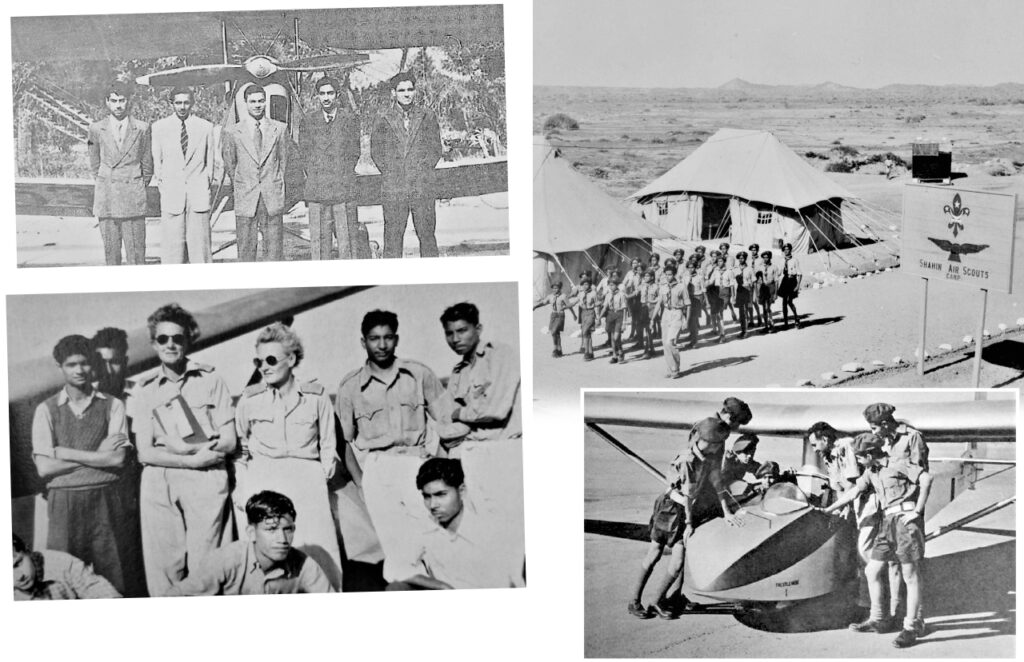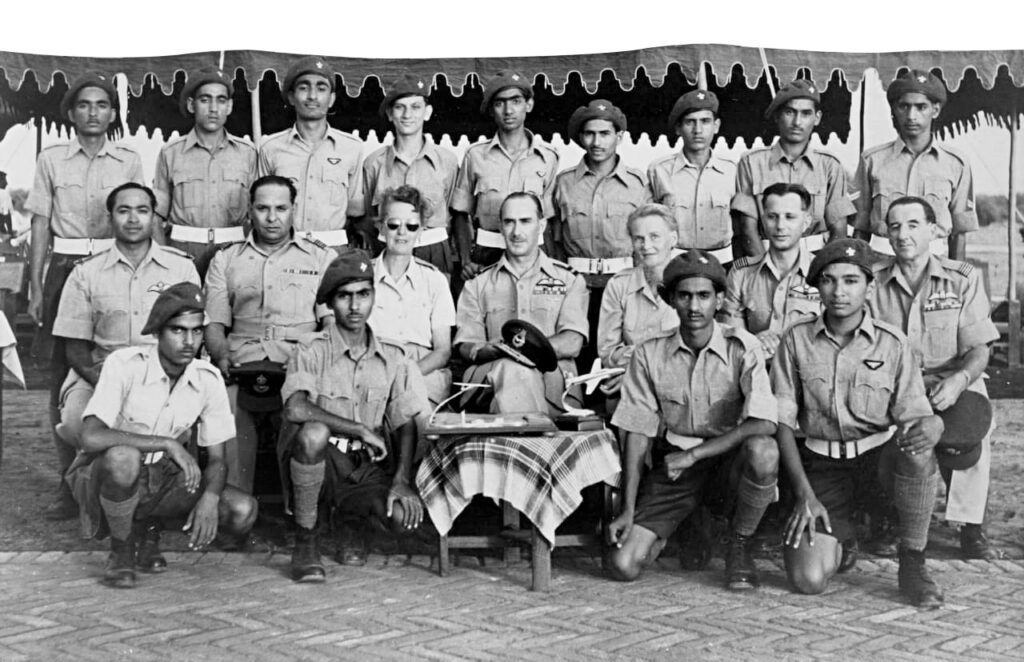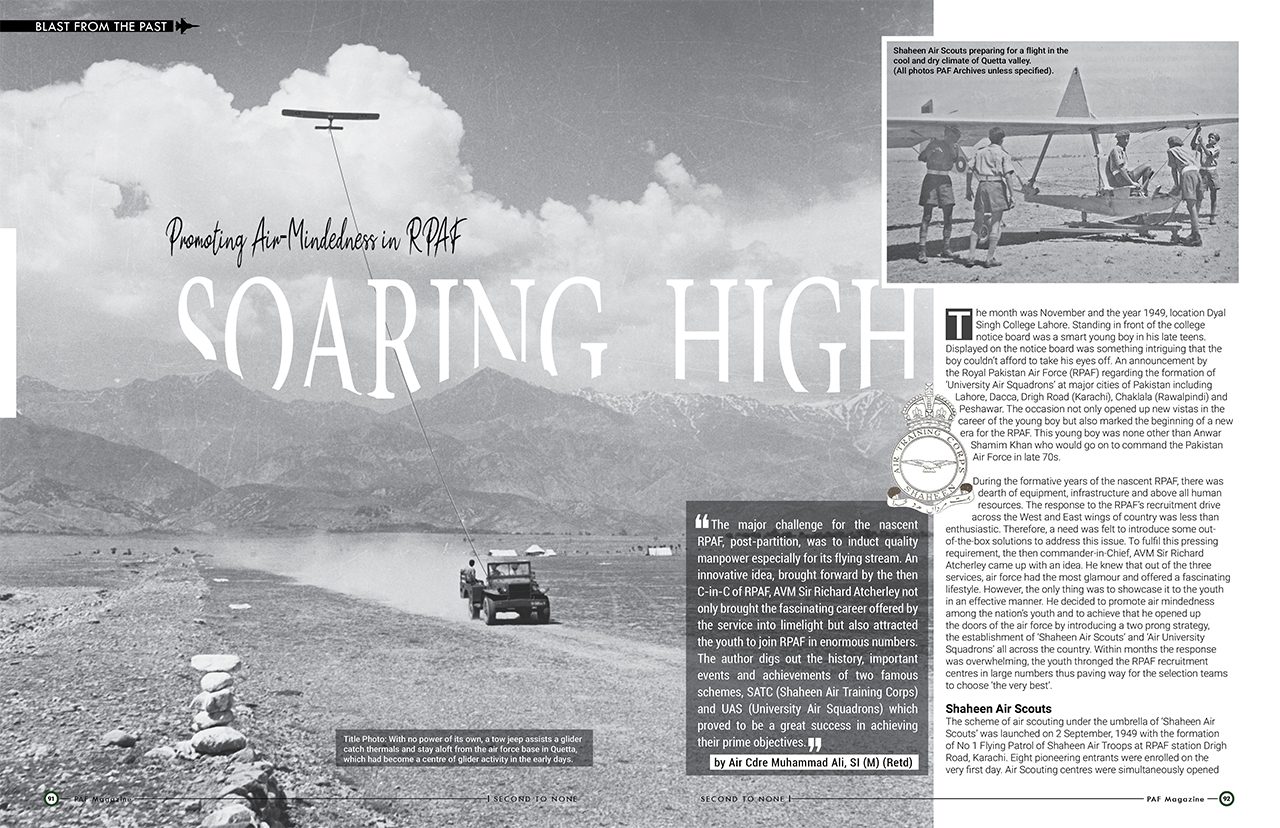The major challenge for the nascent RPAF, post-partition, was to induct quality manpower especially for its flying stream. An innovative idea, brought forward by the then C-in-C of RPAF, AVM Sir Richard Atcherley not only brought the fascinating career offered by the service into limelight but also attracted the youth to join RPAF in enormous numbers. The author digs out the history, important events and achievements of two famous schemes, SATC (Shaheen Air Training Corps) and UAS (University Air Squadrons) which proved to be a great success in achieving their prime objectives.
The month was November and the year 1949, location Dyal Singh College Lahore. Standing in front of the college notice board was a smart young boy in his late teens. Displayed on the notice board was something intriguing that the boy couldn’t afford to take his eyes off. An announcement by the Royal Pakistan Air Force (RPAF) regarding the formation of ‘University Air Squadrons’ at major cities of Pakistan including Lahore, Dacca, Drigh Road (Karachi), Chaklala (Rawalpindi) and Peshawar. The occasion not only opened up new vistas in the career of the young boy but also marked the beginning of a new era for the RPAF. This young boy was none other than Anwar Shamim Khan who would go on to command the Pakistan Air Force in late 70s.
During the formative years of the nascent RPAF, there was dearth of equipment, infrastructure and above all human resources. The response to the RPAF’s recruitment drive across the West and East wings of country was less than enthusiastic. Therefore, a need was felt to introduce some out-of-the-box solutions to address this issue. To fulfil this pressing requirement, the then commander-in-Chief, AVM Sir Richard Atcherley came up with an idea. He knew that out of the three services, air force had the most glamour and offered a fascinating lifestyle. However, the only thing was to showcase it to the youth in an effective manner. He decided to promote air mindedness among the nation’s youth and to achieve that he opened up the doors of the air force by introducing a two prong strategy, the establishment of ‘Shaheen Air Scouts’ and ‘Air University Squadrons’ all across the country. Within months the response was overwhelming, the youth thronged the RPAF recruitment centres in large numbers thus paving way for the selection teams to choose ‘the very best’.
Shaheen Air Scouts

The scheme of air scouting under the umbrella of ‘Shaheen Air Scouts’ was launched on 2 September, 1949 with the formation of No 1 Flying Patrol of Shaheen Air Troops at RPAF station Drigh Road, Karachi. Eight pioneering entrants were enrolled on the very first day. Air Scouting centres were simultaneously opened at other RPAF stations as well including Lahore, Chaklala, Peshawar and Dacca. RPAF recruiting teams stationed on these air bases regularly visited the local schools to promote air mindedness among the students. The objective was to select from them the bulk of future aircrew for the RPAF. Boys between thirteen and eighteen years of age from the local schools in the vicinity of these air stations were recruited and were given training in various disciplines including aeromodelling, gliding and aeronautical subjects. The students were given uniforms at a very nominal price, free pick & drop from their schools to RPAF stations and also free meals were served in the air force messes during their visits.
As envisaged, the scheme proved to be a great success producing gratifying results. By December 1950, some 2000 students got themselves registered with RPAF as the air scouts. Keeping in view the astounding success of the program, AHQ decided to upgrade the scheme and the program was renamed as ‘Shaheen Air Training Corps’ (SATC). For the first time the objective of the corps was officially defined which stated, “To promote and encourage, among boys, a practical interest in aviation and to make them suitable for service in RPAF, to foster in them a spirit of adventure, and to develop the quantities of mind and body which go into the making of a good leader and a good citizen.”
The training of the air scouts was carried in two phases, each lasting for two years. In the first phase the students were given instructions in subjects like service customs, civic sense, physical training and target firing practice. The second phase was more fascinating for the young students as it offered them a chance to practically apply themselves in the art of flying. It included gliding, elementary airmanship, aero-modelling and workshop maintenance of gliders. On top of it all, during summer vacations, the students were to attend a six week long air scouting camp held annually. This was the activity to which every scout used to wait anxiously. These annual camps provided an opportunity to these young students to rub shoulders with the RPAF pilots to whom they always looked up to and tried to learn a trick or two from their personal flying experiences. The first such camp was held at Chaklala from May to July 1951. Subsequently, it was held annually at other stations, Samungli (Quetta) in 1952, Peshawar 1953 and Parachinar in 1954. As the camps gained more popularity among the youth, it was decided to introduce an inter-wing scouting competition as well, the first such competition was held at Sargodha in 1954.
Obviously for the students, gliding remained the most sought-after phase of the entire training curriculum. Being the first step into the fascinating world of flying career, gliding always drew the youngsters by the hundreds. It was this aspect which led the RPAF leadership to establish the ‘Central Gliding School’ at Drigh Road on 1 May 1950. The pioneering institute of the then nascent RPAF played a pivotal role in imparting flying training to the potential pilots. While acknowledging the services of the school, it would be unjust not to recognise the herculean efforts put in by its legendary instructors. These were times when the recently recruited Polish pilots and technician were seen everywhere in RPAF, giving a helping hand whenever and wherever needed. Central Gliding School was no different. Perhaps it would be fair if we attribute the initial achievements of this prime institution to the Poles and especially one Pole, Flg Off (later retd as Sqn Ldr) Zbigniew Mikulski. In November 1949, he was tasked by the RPAF leadership to establish the Central Gliding School at Drigh Road.

Mikulski was a highly experienced glider instructor with some record breaking performances to his credit. His heroics were not limited to gliders only. He was recognised as the ‘King’ of solo aerobatics whose memorable performances used to mesmerise large audiences during official air displays conducted by RPAF. Luckily, he was not alone in this challenging task. His wife Maria Aniela Younga Mikulska, a Civilian Gazetted Officer of RPAF also joined hands in raising the school from scratch. Ms Mikulska was no ordinary lady. Since 1930s, she was engaged in glider flying back home. She was regarded as the first female glider pilot and first female instructor pilot of Poland, earning several Polish National Soaring records. The couple later became gliding legends in the RPAF, owing to their stellar performances in soaring. The couple was later joined by another towering personality, Ms Zofia Turowicz, wife of the famous Pole, Air Cdre Turowicz. Together they jelled as a team and played an anchoring role in the training of budding RPAF cadets. Soon after taking over the command of school in May 1950, Flt Lt Mikulski persuaded the AHQ to open up four more glider training units at Lahore, Chaklala, Peshawar and Dacca. Replicating the successes of the initial units, it was decided to extend the training to other areas as well. Thus came into existence three more units at Chittagong, Kohat and Samungli (Quetta). A year later two more female glider pilots joined the group of instructors. Ms Banu Ahmed, the first Pakistani lady to learn gliding and obtain ‘A’ category in instructional flying. Another WWII pilot Rea joined them thus completing the team of instructors. Under this arrangement, the first glider training course was launched in later months of 1950. Air Scouts from all eight units joined the pioneering course. The course became an annual feature held at Drigh Road only, however, after 1955, Samungli was chosen as the alternate location for conducting gliding courses as it offered a more conducive climate, considered best for soaring.
EoN ‘Baby’ Olympia gliders were used for imparting glider training to students at Drigh Road. Designed and produced by Elliotts of Newbury, EoN Olympia 1 (Type 5) glider flew its first flight in January,1947. Weighing almost 300 Kgs with a wing span of 50 feet, these dashing EoN gliders soared high in warm and humid climate of Karachi. These large-winged birds were a common sight for the local populace during those early years after independence and also a great way to attract the youth for recruitment into RPAF. Mikulski, being an experienced gliding pilot, also improvised new techniques and methods to simplify flying procedures. He worked on improving ground base for gliding, by introducing towing jeeps fitted with glider towing winches. This arrangement significantly reduced flying costs and also made the system more efficient.
In 1952, Air Cdre Farooq Haider (Retd), received his A and B licences on “Eon Primary” and the “Sedberg.” He could climb to 1, 000 feet, remain airborne like an eagle, circuiting close to the home base during practice and land. “Primary was my baby. You could find me in the primary all the time,” he recalled. Later, in the Sedberg, he was manoeuvring, stalling, spinning, side slipping and rapidly losing height. By the time, Farooq Haider earned his C licence in June 1955, endorsed by Sqn Ldr Zbigniew Mikulski himself, he was only 12 years old, not even old enough to drive a car. From then on he was competing and catching air currents to soar higher than ever. The veteran remembered a sortie from 1957, when he soared for 7 hours 15 minutes and 25 seconds. “We took off at 10 am and landed at 5:15 pm. The currents took us to model town, Shahdara and in the end we intentionally headed back to base. It was the month of May, and it was freezing at that altitude,” Farooq Haider (Retd) recalled is a well-known PAF veteran of both the wars against India. Being an Air Defence controller during 1965, he played a key role in achieving large number of aerial kills for the PAF pilots.
He stopped gliding after 1958, when he joined the air force. “But I continued with aeromodelling, a hobby that won me many competitions,” he said.

People soared for different reasons. For Air Cdre Farooq Haider (Retd), it represented tremendous amounts of freedom. “Sail planes were items of superb beauty. It used to be so quiet, just whistling through the air while soaring with the hawks and learning the moods of the air. I remember constantly seeking out sources of lift to compensate for the glider’s otherwise descent through the air,” Air Cdre Farooq Haider (Retd) said, describing the beauty of motor-less flights.
For over a decade, SATC imparted glider training to large number of schools boys across the country. Zahid Hussain was one such enthusiast who earned his coveted glider wing from none other than the President of Pakistan, Field Marshal M Ayub Khan. Being the son of the most famous aerobatics pilot of PAF, the legendary Air Cdre FS Hussain, flying was in his genes. “Those were the most memorable days of my life,” Zahid Hussain recollects. “We use to desperately wait for the summer vacations so that we can join the two months gliding camp held at Samungli, Quetta. On ground, the glider ‘eon primary’ looked like a scary wooden-structured plane from the Wright brothers’ times, however, in air it was fun. There were no instrument panels, just the rudimentary flying controls to manoeuvre the sailplane through rising currents,” he added.
Another legendary PAF pilot of international fame, Air Cdre MM Alam was also the product of SATC. He learnt the tricks of trade during his initial flying career from the famous Pole, Flt Lt Muchowski at SATC, Dacca. Being a student of Govt High School at Dacca, young Alam flew with SATC and earned his coveted glider wing during the graduation parade at Quetta. He later joined RPAF College at Risalpur in 1952.
University Air Squadrons
During late 1940s, the youth of the nation had limited choices when it came to selection of attractive careers for themselves. Civil Services of Pakistan and large industrial organisations remained the top fields of choice with Pak Army as the next most sought after. Air Force also remained one of the top careers, however, with its stringent physical/ medical fitness requirements, risky nature of job as a flier and above all high drop-out rate during flying training continued to disenchant youth towards military flying as a profession. This effected the RPAF’s induction process badly during early years and the organisation found it difficult to fill the required quota of pilots for its flying branch. Moreover, the high drop-out rate of candidates during flying training phase at Risalpur also had phenomenal budgetary constraints for the service.
The organisation needed a solution to these problems and needed it fast. Fully cognizant of these challenges, the then C-in-C of RPAF, AVM Atcherley came out with a brilliant plan which later took shape in the form of UAS (University Air Squadrons). The idea was to attract the youth of the colleges and universities with the charm of flying profession and without any compulsion on them to make any commitment to join RPAF. Upon final approval from the AHQ, UAS was officially formed in 1949. The main purpose of the scheme was to attract the keen, healthy and intelligent minds from national universities and colleges. Initially five air squadrons were opened at Drigh Road, Lahore, Chaklala, Peshawar and Dacca. Within months of their formation, the scheme received tremendous response from all across Pakistan. Large number of students from various colleges and universities flocked PAF stations nationwide for registration and enrolment. Auster Aiglet and Tiger Moth aircraft were made available to these UASs.

The primary aim of these units was to give basic feel of flying to students and in turn also to look out for a natural talent among the youth. Another fringe benefit came in the form of curtailing the high drop-out rates of candidates during flying phase at Risalpur. UAS imparted elementary flying training to potential pilots amongst university/ college students thus producing better and flying aptitude-tested group of young cadets for induction at RPAF College Risalpur. The concept was so successful that after some time it was decided by the AHQ to direct all the selected GD (P) candidates to UAS for obtaining elementary flying training, before being inducted at Risalpur. Later, it was also agreed upon that in each course of 25 cadets, 20 would come from UAS. Other than flying training at UAS, the students were also given comprehensive ground schooling on subjects like aerodynamics, aeronautical engineering, radio/ radar, meteorology and service procedures. Upon successful completion of the course, the graduated students were given the rank of Pilot Officer in RPAF VR (Volunteer Reserve).
Poles played an important role in establishing UAS across the country, just they did in case of SATC. Experienced and senior RPAF pilots were tasked to establish these units across East and West wings of Pakistan. Flt Lt Banach established UAS at Lahore, Flt Lt Muchowski at Dacca, Mr Anderson at Rawalpindi, Mr Busby at Peshawar and Mr Walker at Karachi. One of the talented students of Flt Lt Banach was AVM Mehmood Akhtar Bukhari (Retd), who rose to fame during 1965 war by carrying out successful bomber operations.
“I started my flying on Tiger Moth in 1950 being part of UAS at Lahore. My instructor was Flt Lt Banach, a very professional pilot who played an instrumental role in training young students both at UAS and RPAF College, Risalpur,” said AVM Mehmood Akhtar Bukhari (Retd) in an interview. He further added that this experience helped him a lot during professional flying training at Risalpur as he joined RPAF with16 GD (P) course.
Unfortunately, these two brilliant institutes became victims of their own success. For years, they promoted the charismatic image of the ‘Men in Blue’ which resulted in huge numbers of nation’s youth applying for joining the RPAF. Once the recruitment was not a problem anymore for the RPAF, slowly and gradually the need of maintaining such schemes with huge financial constraints was not considered viable any more. Thus began the beginning of the end of these wonderful institutes. By 1961, both the schemes were officially laid to rest. The founding father of these two brilliant schemes, AVM Sir Richard Atcherley, paid rich tributes to these units while addressing at the tenth anniversary of SATC, he said, “Let us remind ourselves anew. Of the aims of SATC and re-pledge ourselves to its objectives: to fit the rising generations to serve Pakistan in the air, and to so develop their minds and bodies that they become good leaders, good citizens, men of honour, self-reliant, and self-disciplined.”
Both the schemes have long since faded from PAF history after achieving their purpose of attracting the cream of the nation into the thrilling and exciting career of military flying. Even today, the majority of PAF veterans trained by these schemes recall those moments of flying the Auster and Tiger Moths with nostalgia and term them to be the most exciting days of their careers.








